Yves here. While I do not watch gasoline market conditions closely, it seems just about certain that the price trajectory is higher. First, we’ve gotten a bit of a break from the China lockdowns, which have cut into Chinese demand for oil and gas. But “second” is a mixed item. Biden has authorized going into the Strategic Petroleum Reserve at the rate of a million barrels a day, which is a bit more than our Russian oil imports. But that’s only for six months. Think the US is prepared to end the sanctions on Russia by then? Not only is that answer likely to be no, Russia is also just about certain not to accept payment (in the event the US were to relent) in anything other than the “pay in roubles” process it set forth for European gas buys. The only way Russia might accept dollars is if the US were to give back the $300 billon in central bank reserves it stole, which is na ga happen.
By Wolf Richter, editor at Wolf Street. Originally published at Wolf Street
Following the dizzying spike in gasoline prices, the question arises when demand destruction will set in, where people start driving less, start taking it easier to conserve gas when they do drive, or start prioritizing the most economical vehicle in their garage. If enough people do it, demand begins to decline, and gas stations have to compete for dwindling business. Demand destruction is what would cause the price to come down again. Are we there yet?
The Energy Department’s EIA measures consumption of gasoline in terms of barrels supplied to the market by refiners, blenders, etc., and not by retail sales at gas stations. The volume of gasoline supplied has fallen for the third week in a row. This is unusual this time of the year, when gasoline consumption normally rises through the summer.
The EIA reported on Thursday that gasoline consumption fell to 8.61 million barrels per day in the week ended April 8 on the basis of a four-week moving average (red line), the lowest since March 4, down 2.3% from the same period in 2021 (black line) and down 8.1% from the same period in 2019 (gray line).
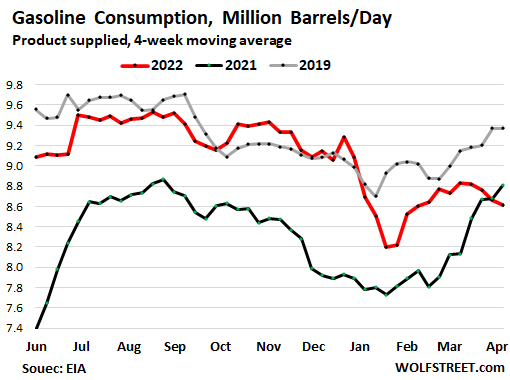
Consumers Began to React in January
Note how the past 11 months (red line) tracked the pre-Covid period three years earlier very closely (gray line) until they began to diverge sharply, not just in March, but already in mid-January, and have been solidly below the 2019 level ever since.
Gasoline prices started shooting higher from collapsed levels in April 2020. By May 2021, the average price of gasoline, all grades combined, breached $3.00 a gallon, a multi-year high, and kept going. In November 2021, it hit $3.40 a gallon and took a break. Then in early February, it started spiking higher and in historic leaps hit $4.32 on March 14.
But since mid-March, the price has ticked down. Now at $4.09, it remains nosebleed high but is a little lower than it was:
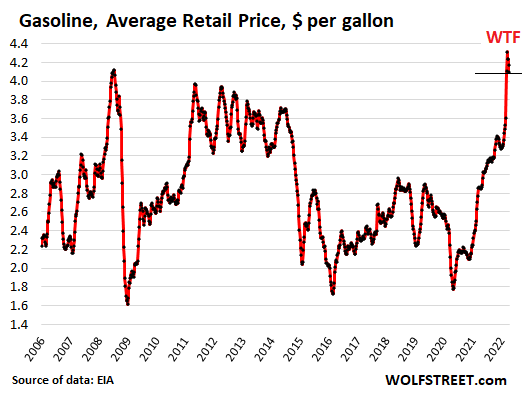
Gas stations don’t lower prices out of the goodness of their heart. They lower prices because sales are getting hit, and price competition has set in among gas stations in an effort to maintain sales volume. And gas stations could lower their selling price without taking a hit to their profit margins as the costs of their product also declined.
Demand destruction that hits gasoline would then be passed through to crude oil demand. But crude oil has far broader uses than just gasoline, including the booming petrochemical industry. And a small decline in demand for gasoline in the US isn’t going to shake up the global crude oil markets all that much.
The Price of Crude Oil Already Bounced Again
Crude oil grade WTI had spiked to $130 a barrel and then fell back into the mid-$90 range. In recent days, it has changed course again and hit $106 now. This is not a good sign for gasoline prices.
Clearly, there has been some demand destruction, and perhaps this was enough to cause the price of gasoline to come back down a little.
But maybe it wasn’t. Maybe this demand destruction wasn’t the cause of the decline in gasoline prices. Maybe they fell for some other reason, such as the current volatility that has hit everything. The wild dynamics of the commodities markets see to that.
My Guess: Gas Prices Will Rise Again
I can see the demand destruction, but for now I remain doubtful that it is big enough to cause a lasting decline in the price of gasoline. I would not be surprised if the price starts heading higher again. Crude oil prices have already started heading higher again. This could be a long-drawn-out process with prices being very volatile and zigzagging higher and higher. That’s my guess.
What We Do Know
Annual gasoline consumption hit a peak in 2007 and then declined over the next five years through 2012 by a total of 6.3%. It then rose again, and hit that 2007-peak again in 2016, and again in 2017, and in 2018, and again in 2019, without going beyond it. And then in 2020, consumption collapsed. In 2021, consumption recovered sharply, but the annual total consumption ended the year still down 5.3% from 2007!
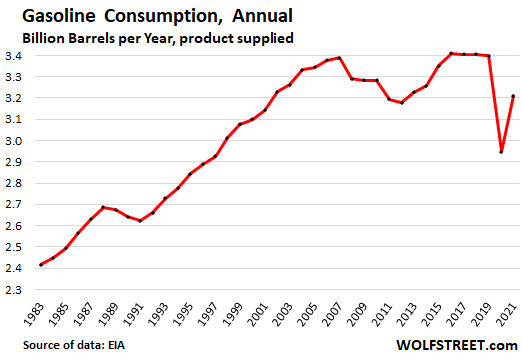
But total vehicle miles driven hit a record every year from 2015 through 2019. And in 2021, despite the collapse in 2020, miles driven were up 6.6% from 2007. People are driving more, but they’re using less gasoline to do so:
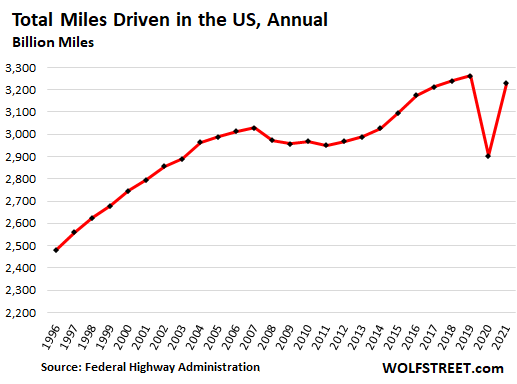
So, there are many other factors that play into gasoline consumption, not just price. This includes long-term technology trends, such as more fuel-efficient vehicles, and the arrival of EVs on a scale that is now large enough to make a dent into gasoline consumption.
Other changes also impact gasoline consumption, some of them dating back well over a decade, such as the building boom of high-rise residential towers in urban centers that reduced or eliminated commutes-by-car for residents; or the trend of working from home at least part of the time that also cuts commuter miles.
Pulling in the opposite direction was the increase in driving vacations during the pandemic, that may by now have been superseded by flying again (domestic leisure traffic is up).
Gasoline consumption is also highly seasonal, which makes it even tougher to spot where demand destruction has occurred due to price, and where unusual seasonal patterns could be at play.
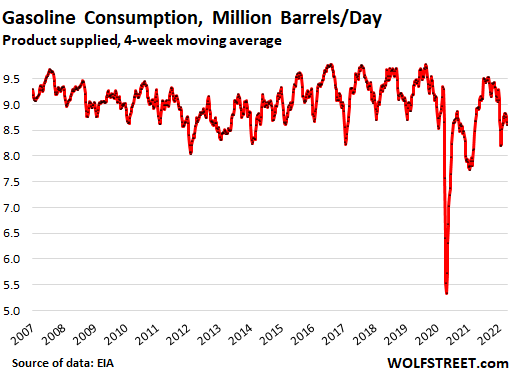


Interesting that total miles driven has nearly rebounded but gasoline consumption is below prior years levels. That would make it even harder to use this as a signal for demand destruction.
I still rather like the American Chemical Societies trend indicators as it covers broad trends like what Wolf is highlighting here and the use of oil in chemical inputs.
https://www.americanchemistry.com/chemistry-in-america/news-trends/weekly-economic-report/2022/weekly-chemistry-and-economic-trends-april-15-2022
This brings up the impact of movements such as anti plastic bag mandates in municipalities, etc. I do notice that plastic recycling is still functioning more as a virtue signalling function than a ‘real’ recycling program. (The “recycled” plastic around here still goes to the landfill.)
Removing the exemption of trucks and SUVs from the CAFE mileage standards would also help a lot. Seeing how most pickup trucks I see on the road now have one driver and no cargo, a better metric to measure the “efficiency” of motor vehicles in America might be ‘joules of energy expended per kilogram of cargo moved per mile.’
Bicycle: 55 MPB Miles per burrito
I can only get about 20 miles from one of those. Guess I’m going to have to buy better burritos.
jefemt
A fart in a windstorm, I fear.
Also, if my recent experiences on the local roads peddling myself from point A to point B are any measure, very dangerous as well.
The ‘homeless’ and the ‘addicts’ lead the way here. Many of ‘them’ ride bikes out of necessity. Bicycle theft here is a growth industry. Locals now have to lock up their velocipedes on their own front porches, during the day. The local police act as if they have more important things to do than hunt down bicycle thieves, even when given clear photographic representations of the miscreants. The “word on the street” I am hearing is that, given the aforementioned, Citizens will have to ‘take justice into their own hands.’ (A quote from a recent rant on the Nextdoor quora, [which was quickly deleted by the moderators.]) I hear similar sentiments from ‘real live people’ I speak to, out and about.
This is classic misdirection on the part of the PTBs. Get the ‘Lower Orders’ fighting amongst themselves and the ‘Top Layers’ can serenely ride above the fray.
Concerning the Police: Stupid or Evil?
Leave decoy bikes around which cannot be traced back to whomever left them around. Coat the handlebars and seat and brake handles with poison ivy oil. Let thieves take them and let the poison ivy oil do its work.
But make very sure the origin of the decoy bikes really is untraceable and altogether unguessable.
I wonder how Homeland Security would classify a company that sold Poison Ivy Oil.
I have used a variation of this tactic to “discourage” local weekender punks, yes, real underage ‘s–t kickers’ on four wheelers, from using the corner of our former exurban half acre as a mud riding trail. After signs and personal remonstrances failed to stop the ravening hordes from despoiling our place, I crept out one night and strung big creeper vines of the dreaded poison ivy across their main trail a few dozens of yards away from our place. The next weekend, in the morning, they cruised through the course as usual, but by the afternoon thay became strangely silent. They never came back.
First, I will observe that the local police stated that, since the ‘perps’ were underage, there was almost nothing they, the police, could do about it.
Second, these were ‘weekenders.’ The outer bands of “civilization” are often used as recreation spots on the weekends by the middle classes. So, social pressures are almost useless as tools of behaviour modification.
Third, as “natural” objects, locally found, the ivy vines could be “plausibly denied.”
Fourth, said vines are a non-lethal tool. A country version of rubber bullets if you will.
Fifth, the local population generally despises the ‘weekender’ crowd and stays silent in the face of questioning. Sullen, uncooperative “deplorables” have reasons for being so. Most of the ‘weekenders’ we saw and interacted with when we lived down by the coast were, for the most part, insulated bubble dwellers. They were ‘there’ to satisfy their own desires and often considered the desires or needs of the locals as inconveniences to be overriden or pushed aside.
When I lived on Miami Beach, calling someone “Tourist” was an insult. The word was generally preceded by a descriptive word or phrase denoting personal moral insufficiency.
Still, I shall hijack your idea and try and spread it around the network.
Stay safe, and happy cider making!
It would be better not to buy it or sell it. Just learn how to harvest and refine one’s own.
Given the spreading symptoms in EU, I am expecting $12 gallon in the near future for gasoline, before it goes into real ‘shock’. A missile in the wrong place and time has not entered the risk equation in a meaningful way.
“Other changes also impact gasoline consumption, some of them dating back well over a decade, such as the building boom of high-rise residential towers in urban centers that reduced or eliminated commutes-by-car for residents; or the trend of working from home at least part of the time that also cuts commuter miles.”
And countries have declining birth rates.
No longer double digit birth rates for developing countries either.
But again, I think there will continue to be rises in prices as a way for companies to keep growing profit margins. They will have less competition. Will have to squeeze more dollars. That’s the big appeal of moving people to online shopping – the abitlity to show different prices for the same goods to different people.
Gasoline prices have been dropping nationwide over the past few weeks. Perhaps it is temporary, perhaps not. Sustained high gasoline prices are a political non-starter in the US of A. Big Oil knows this as well as the politicos. They will squeeze right up until the political pressure becomes too much to bare, and then they will back down. Coffee beans and eggs can sharply increase in price. Gasoline can never.
This is an opportunity for “middle-class-and-above” accelerationists to use and burn as much gas as possible to drive the price up beyond affordability for a hundred million people. Then see what happens.
What pisses me off is that no car company I know of operating in America has pushed an ultra compact car yet. I take note of the Fiat Chrysler attempt to sell the 500 class ‘compact’ vehicle in America, but notice that it seems to have flopped. As for ‘compact’ pickup trucks, crickets. Those smaller trucks with the plain four cylinder engines were robust and useful.
America does not have a national industrial planning department, and it shows.
The real action as I see it will be in the natural gas supplies. That fuel has been promoted as the ‘cleaner burning’ alternative to coal and oil for years now and has become critical in energy production. Once the reasonably priced fracked gas “peak” is reached, inflation will really take off.
Hopefully, the ‘demand shock’ resulting from an energy squeeze won’t be fatal to too many people.
Finally, the present era is based on a misconception of the nature of science. The myth is that every problem can be solved with science. Science does not really work that way. So many of the scientific discoveries in the past have been the result of “happy accidents” or unexpected byproducts of research.
Social problems generally are solved through the use of that most basic of social processes, politics. Business and science are not politics. The proto neo-liberals promoted the idea that government would become “efficient” when run along the lines of a business enterprise. The quants promoted the idea that society can be quantified and managed along “scientific” lines. The two groups made an unholy alliance, and today’s dysfunctional society is the result.
I hope I do not live long enough to see the end game of all this. I really did have hope that everything would get better and better when I was younger. Now I’m a cynical old geezer.
it would take gas at or over $10 a gallon for promised years to come to torture car companies into making ultra-compacts and torturing enough of a customer base into existence for car companies to make them for.
This might be a good time for people who can afford it to buy and waste all the gas they possibly can to drive the price above what most people can pay . . . . and keep it there long enough to get most people seeking relief through an ultra-subcompact car.